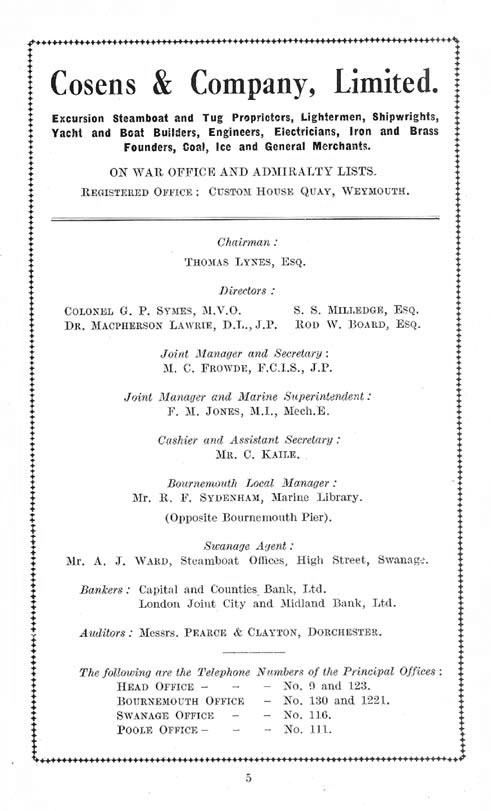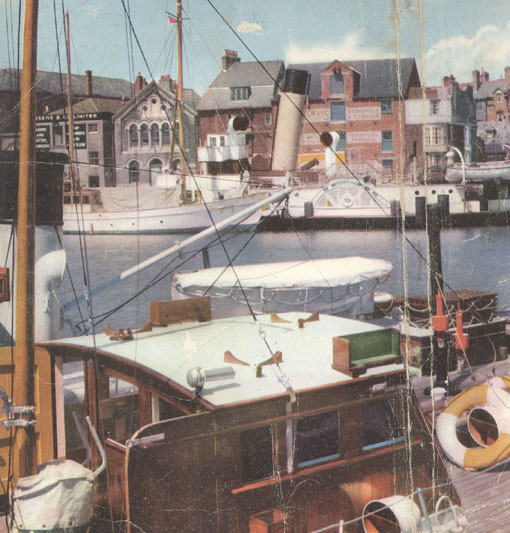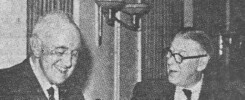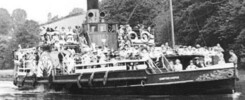
Cosens & Co was a dominant force in Weymouth from the middle of the nineteenth century for a hundred years. The business is remembered largely as the operators of elderly excursion paddle steamers but they did so much more as this extract from their 1923 guidebook recounts:
The activities of the firm are by no means confined to their pleasure steamers, other branches have been developed, and have flourished to such an extent that today Messrs Cosens and Co hold a leading position among the many commercial concerns in the neighbourhood. Possibly no branch of the company’s activity made such rapid strides as the shipbuilding and repairing, iron-founding and engineering. From the decease of the late Mr Collett, the company acquired his old-established family business, to which considerable extensions were speedily made developing it as a marine and general engineers. Business was removed to the site of the old theatre, upon which, and the land adjoining, were erected fitting shops and workshops fitted with modern machinery. These works soon became the centre of a very important and rapidly increasing trade. Adjoining them is a wharf, which affords direct access to the yard by rail or water. In 1877 and again in 1895, important local ship businesses were taken over by the company, and were at once modernised and transformed. Slipways were made thoroughly up-to-date, and a cradle for docking ships, with all the necessary appliances for dealing promptly and efficiently with this class of work installed. The value of these acquisitions from a business and industrial point of view may be judged by the fact that they led to the employment of a staff of hands numbering 250, which was considerably augmented during the war. The whole of the establishments are lighted by electricity, and no effort is spared to keep the plant, etc, completely modern. The company, who are upon the Admiralty and War Office lists, have consequently been the means of introducing work to Weymouth from all parts of the coast, including from time to time orders from the various warships that visit Portland Roads. This has been the means of providing considerable work for the mechanics of the town, and acquired for the firm an enviable reputation for promptness and general excellence of work. For several years the firm were the only representatives of electrical enterprise in Weymouth, and in addition to the installation of electric light at their own works, offices, etc they were the means of providing similar lighting for many of the principal businesses of the town. The youth of Weymouth will have every reason to remember Cosens & Co as a stepping-stone into the engineering world, for many otherwise would have been barred from such a privilege.

Today when electricity is ubiquitous and seminal in our modern world, which would collapse in its present form without it, it is salutary to remember what a relatively recent power source it is. The Savoy Theatre in London, built by businessman Richard D’Oyly Carte with W S Gilbert and Arthur Sullivan on the back of the runaway financial success of their operettas, was, in 1881, the first public building in Britain to be lit by this miraculous new source of lighting free from all the noxious products of combustion emanating from gas. D’Oyly Carte bought a 120HP Siemens steam generator for the purpose which was set up on open land outside the theatre and powered 1,200 Swan ‘incandescent light bulbs’ within. The show which opened to this new ‘fume free’ lighting was Gilbert and Sullivan’s Patience, a witty social satire mocking the greater absurdities and worst excesses of artistic pretension. ‘Oh to be wafted away from this black Aceldama of sorrow, where the dust of an earthy today is the earth of a dusty tomorrow’. That sort of thing…
HMS Inflexible, an iron-clad battleship built in 1870, was, in 1881, the first Royal Navy ship to have electricity installed providing a massive 800 volts DC. She was also the first on which a seaman was electrocuted after which the power was reduced to 80 volts. The liner Servia, built in 1881, was the first Cunarder to have the electric light.
Electricity spread slowly elsewhere with towns gradually developing their own independent supplies often using different voltages from, and therefore incompatible with, electricity generated by neighbouring boroughs. Weymouth’s first power station, ‘Sunnybrook’ sited in nearby Westham, did not open for business until September 1904 nearly a quarter of a century after the Navy had switched on their electric lights. The National Grid, linking together towns, standardising voltage and paving the way for electricity to light most homes, started distributing its power only in 1933.
Ships were therefore ahead of the curve here. Cosens were on the Admiralty and War Office lists for work for the Navy so had to be in the forefront of all the new technologies as they came online. It was therefore Cosens which brought electrical expertise to Weymouth ahead of anyone else. They even had their own generating plant for their own works which, never missing commercial business opportunities, was also able to supply ‘many of the principal businesses of the town’ as well.
Even after the National Grid arrived the old ways did not disappear overnight. As late as the 1950s some ship owners, including the Orient Line, were still building their vessels with DC rather than the more usual 240v AC. Gas was still in use for lighting in some places, like Weymouth railway station, right up to the early 1970s.
We tend to think of Cosens as operators of elderly excursion paddle steamers catering for a market from a bygone age but actually, in their heyday, they were at the cutting edge of technology, a sort of 19C Dorset version of Silicon Valley.
Kingswear Castle returned to service in 2023 after the first part of a major rebuild which is designed to set her up for the next 25 years running on the River Dart. The Paddle Steamer Kingswear Castle Trust is now fund raising for the second phase of the rebuild. You can read more about the rebuilds and how you can help if you can here.
John Megoran


